如何使用YOLOv8训练自己的模型和进行预测
准备文件夹
删除重复的照片。然后以图片采集的日期新建一个文件夹,如“2023.6.19”,并在其中新建一个名为VOCdevkit的文件夹,VOCdevkit里面创建一个名为JPEGImages的文件夹存放需要打标签的图片文件;再创建一个名为Annotations存放标注的标签文件;最后创建一个名为 predefined_classes的txt文件来存放所要标注的类别名称。
如下图所示:
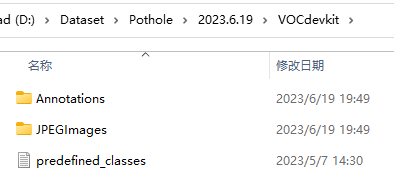
在JPEGImages这个文件夹中放置待标注的图片。
在 predefined_classes这个txt文档里面输入定义的类别种类,如下图所示:
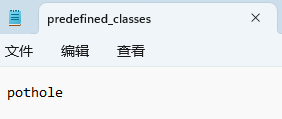
接着进行以下5步处理:
(1)重命名;
(2)统一为纵向;
(3)统一分辨率;
(4)利用labelimg进行标注
(5)数据增强;
1. 重命名
对JPEGImages文件夹中的照片进行批量重命名。
具体操作为:将folder_path替换为JPEGImages文件夹的绝对路径;new_name替换为你想要的新文件名前缀。
import os
def rename_files(folder_path, new_name):
files = os.listdir(folder_path)
for index, file in enumerate(files):
file_extension = os.path.splitext(file)[1]
new_file_name = f"{new_name}_{index}{file_extension}"
os.rename(os.path.join(folder_path, file), os.path.join(folder_path, new_file_name))
print(f"Renamed {file} to {new_file_name}")
# 用法示例
folder_path = "D:\Dataset\Pothole\2023.6.19\VOCdevkit\JPEGImages" # 替换为你的文件夹路径
new_name = "img2023.06.19" # 替换为你想要的新文件名前缀
rename_files(folder_path, new_name)
2. 统一图片横纵向方向
将JPEGImages文件夹中的照片统一为纵向。
具体操作为:将folder_path替换为JPEGImages文件夹的绝对路径,将JPEGImages文件夹中的照片统一为纵向。
from PIL import Image
import os
folder_path = "D:\Dataset\Pothole\2023.6.19\VOCdevkit\JPEGImages" # Replace with the actual folder path
# Iterate over the files in the folder
for filename in os.listdir(folder_path):
if filename.endswith(".jpg") or filename.endswith(".png"): # Adjust file extensions as needed
file_path = os.path.join(folder_path, filename)
# Open the image
image = Image.open(file_path)
width, height = image.size
# Compare horizontal and vertical pixel values
if width > height:
# Rotate the image 90 degrees clockwise
rotated_image = image.rotate(-90, expand=True)
# Save the rotated image, overwrite the original file
rotated_image.save(file_path)
print(f"Image '{filename}' rotated.")
else:
print(f"No operation required for image '{filename}'.")
3. 统一图片分辨率
将JPEGImages文件夹中照片的分辨率进行统一。
具体操作为:将folder_path替换为JPEGImages文件夹的绝对路径;将target_resolution替换为你的目标分辨率,由于我的手机拍摄的照片为3:4,所以此处的目标分辨率最好也为3:4,如900:1200、720:960。
from PIL import Image
import os
def resize_images(folder_path, target_resolution):
# 遍历文件夹中的所有文件
for filename in os.listdir(folder_path):
file_path = os.path.join(folder_path, filename)
# 检查文件是否是图片
if not os.path.isfile(file_path) or not any(
file_path.endswith(extension) for extension in ['.jpg', '.jpeg', '.png']):
continue
# 打开图片
image = Image.open(file_path)
# 获取原始分辨率
original_resolution = image.size
# 计算调整比例
ratio = min(target_resolution[0] / original_resolution[0], target_resolution[1] / original_resolution[1])
# 计算调整后的尺寸
resized_size = (int(original_resolution[0] * ratio), int(original_resolution[1] * ratio))
# 调整图片分辨率
resized_image = image.resize(resized_size)
# 创建空白画布
canvas = Image.new('RGB', target_resolution, (255, 255, 255))
# 在画布上居中粘贴调整后的图片
offset = ((target_resolution[0] - resized_size[0]) // 2, (target_resolution[1] - resized_size[1]) // 2)
canvas.paste(resized_image, offset)
# 保存调整后的图片
canvas.save(file_path)
# 指定文件夹路径和目标分辨率
folder_path = 'D:\Dataset\Pothole\2023.6.19\VOCdevkit\JPEGImages' # 替换为你的文件夹路径
target_resolution = (720, 960) # 替换为你的目标分辨率
# 调用函数进行图片分辨率统一
resize_images(folder_path, target_resolution)
4. 利用labelimg标注数据集
4.1 labelimg介绍
Labelimg是一款开源的数据标注工具,可以标注三种格式。
(1)VOC标签格式,保存为xml文件。
(2)yolo标签格式,保存为txt文件。
(3)createML标签格式,保存为json格式。
4.2 labelimg在Windows下的安装
打开cmd命令行(快捷键:win+R)。进入cmd命令行控制台。输入如下命令并运行:
pip install labelimg -i https://pypi.tuna.tsinghua.edu.cn/simple。
出现如下红色框框中的告诉我们成功安装的时候,说明labelimg安装成功了。

4.3 使用labelimg
在VOCdevkit文件夹下右击,选择”在终端中打开“。
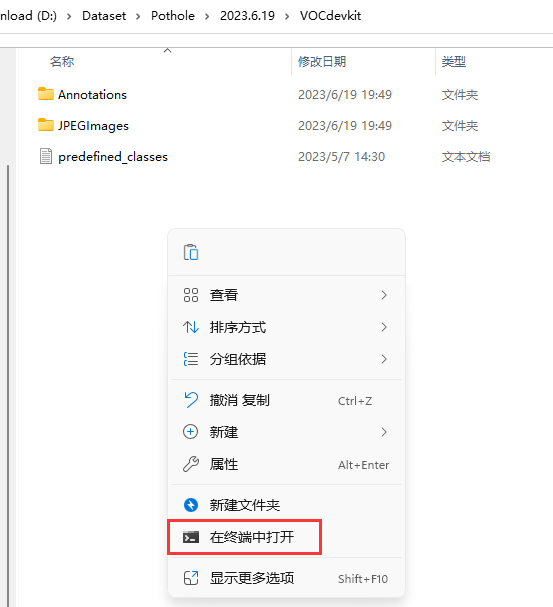
输入如下命令打开labelimg:labelimg JPEGImages predefined_classes.txt
这个命令的意思是打开labelimg工具;打开JPEGImage文件夹,初始化predefined_classes.txt里面定义的类。

运行如上的命令就会打开这个工具,如下。
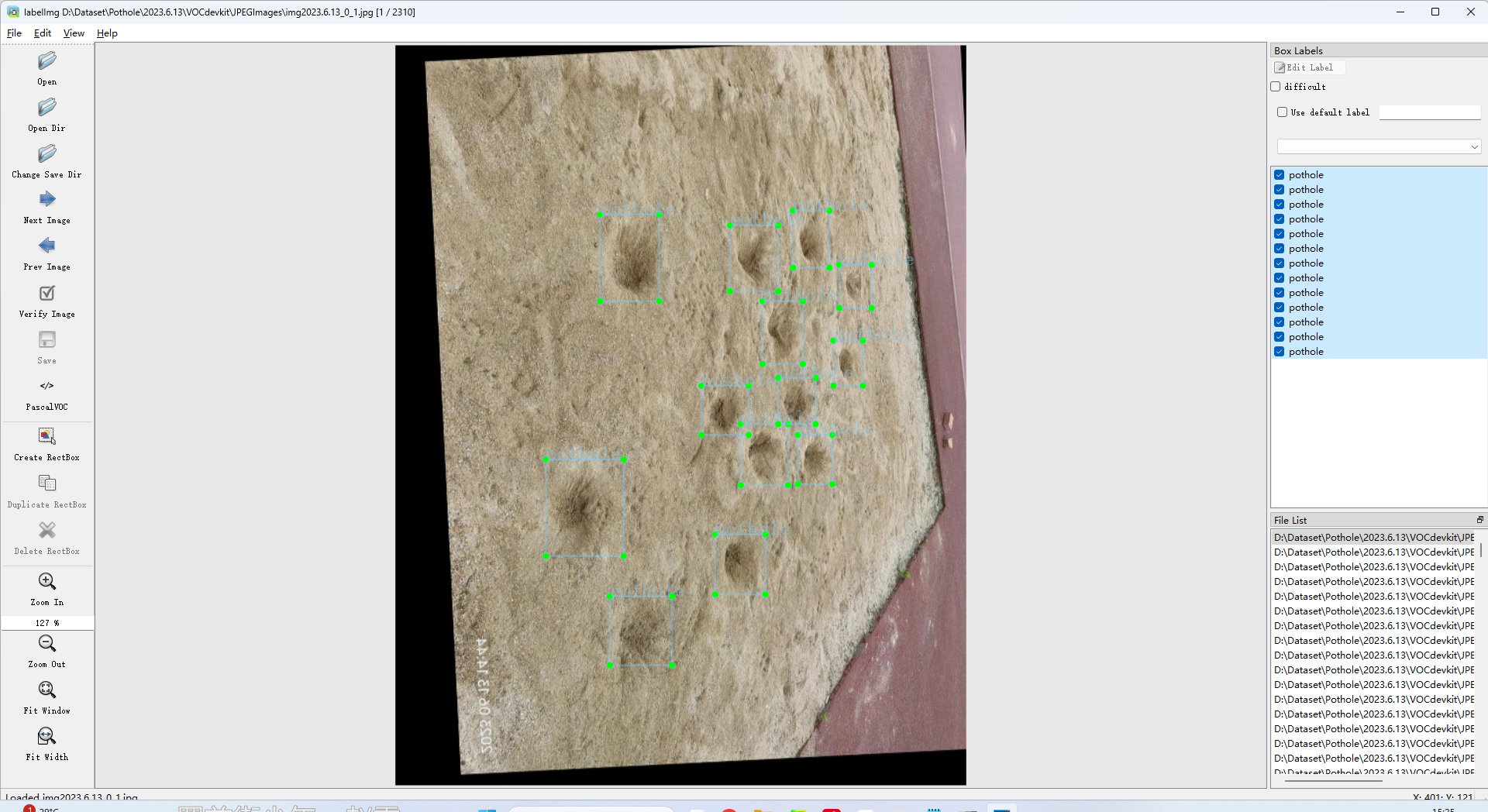
常用按钮:
 :待标注图片数据的路径文件夹,选择JPEGImages文件夹。
:待标注图片数据的路径文件夹,选择JPEGImages文件夹。
 :保存类别标签的路径文件夹,选择Annotations文件夹。
:保存类别标签的路径文件夹,选择Annotations文件夹。
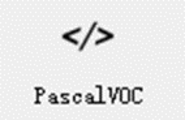 :选择标注的标签为PascalVOC(xml)格式。
:选择标注的标签为PascalVOC(xml)格式。
接下来,点击view,会出现如图红色框框中的选项。勾选以下三项:
Auto Save mode:切换到下一张图的时候,会自动保存标签。
Display Labels:会显示标注框和标签
Advanced Mode:标注的十字架会一直悬浮在窗口。

4.3.3 开始标注
对JPEGImages文件夹中所有图片逐个进行标注:
按快捷键W,然后选定我们需要标注的对象。按住鼠标左键拖出框框就可以了。如下图所示,当我们选定目标以后,就会加载出来predefined_classes.txt 定义自己要标注的所有类别。打好的标签框框上会有该框框的类别。然后界面最右边会出现打好的类别标签。打好一张照片以后,快捷键D,就会进入下一张。在Annotations文件夹中会自动保存标签文件,而且标签文件的名称会与JPEGImages中对应图片的名称一致。
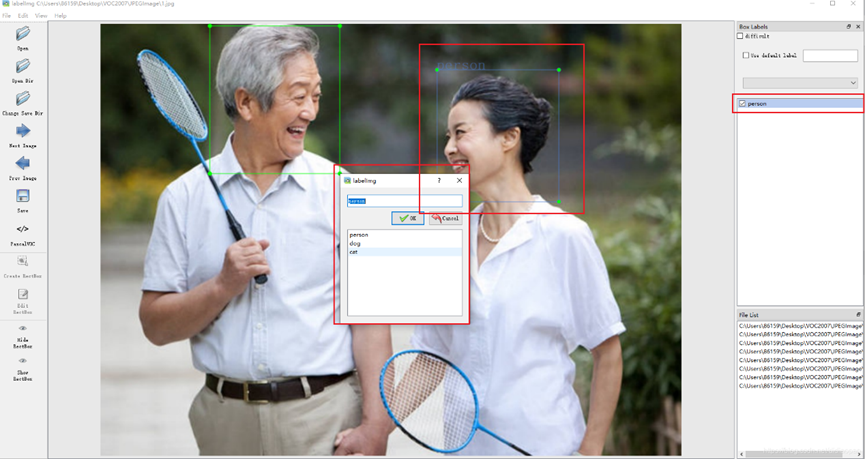
5.进行数据增强
(1)在“2023.6.19”文件夹中建立一个DataAugForObjectDetection_5文件夹,将进行第4章处理后得到的VOCdevkit文件夹复制粘贴到DataAugForObjectDetection_5文件夹中,并在DataAugForObjectDetection_5文件夹中新建一个DataAugmentforLabelImg.py如下图所示:

(2)在VOCdevkit文件夹中新建两个子文件夹:JPEGImages2和Annotations2,最终VOCdevkit文件夹中包含四个子文件夹,如下图所示:

(3)在(1)中创建的DataAugmentforLabelImg.py文件中放入以下代码,运行后会分别在JPEGImages2和Annotations2文件夹中产生扩充后的图片和标签文件。
(4)运行过后删除VOCdevkit里的JPEGImages和Annotations文件夹,并将得到的JPEGImages2和Annotations2文件夹分别改名为JPEGImages和Annotations。
# -*- coding=utf-8 -*-
##############################################################
# description:
# data augmentation for obeject detection
# author:
# pureyang 2019-08-26
# 参考:https://github.com/maozezhong/CV_ToolBox/blob/master/DataAugForObjectDetection
##############################################################
# 包括:
# 1. 裁剪(需改变bbox)
# 2. 平移(需改变bbox)
# 3. 改变亮度
# 4. 加噪声
# 5. 旋转角度(需要改变bbox)
# 6. 镜像(需要改变bbox)
# 7. cutout
# 注意:
# random.seed(),相同的seed,产生的随机数是一样的!!
import time
import random
import copy
import cv2
import os
import math
import numpy as np
from skimage.util import random_noise
from lxml import etree, objectify
import xml.etree.ElementTree as ET
import argparse
# 显示图片
def show_pic(img, bboxes=None):
'''
输入:
img:图像array
bboxes:图像的所有boudning box list, 格式为[[x_min, y_min, x_max, y_max]....]
names:每个box对应的名称
'''
for i in range(len(bboxes)):
bbox = bboxes[i]
x_min = bbox[0]
y_min = bbox[1]
x_max = bbox[2]
y_max = bbox[3]
cv2.rectangle(img, (int(x_min), int(y_min)), (int(x_max), int(y_max)), (0, 255, 0), 3)
cv2.namedWindow('pic', 0) # 1表示原图
cv2.moveWindow('pic', 0, 0)
cv2.resizeWindow('pic', 1200, 800) # 可视化的图片大小
cv2.imshow('pic', img)
cv2.waitKey(0)
cv2.destroyAllWindows()
# 图像均为cv2读取
class DataAugmentForObjectDetection():
def __init__(self, rotation_rate=0.5, max_rotation_angle=5,
crop_rate=0.5, shift_rate=0.5, change_light_rate=0.5,
add_noise_rate=0.5, flip_rate=0.5,
cutout_rate=0.5, cut_out_length=50, cut_out_holes=1, cut_out_threshold=0.5,
is_addNoise=True, is_changeLight=True, is_cutout=True, is_rotate_img_bbox=True,
is_crop_img_bboxes=True, is_shift_pic_bboxes=True, is_filp_pic_bboxes=True):
# 配置各个操作的属性
self.rotation_rate = rotation_rate
self.max_rotation_angle = max_rotation_angle
self.crop_rate = crop_rate
self.shift_rate = shift_rate
self.change_light_rate = change_light_rate
self.add_noise_rate = add_noise_rate
self.flip_rate = flip_rate
self.cutout_rate = cutout_rate
self.cut_out_length = cut_out_length
self.cut_out_holes = cut_out_holes
self.cut_out_threshold = cut_out_threshold
# 是否使用某种增强方式
self.is_addNoise = is_addNoise
self.is_changeLight = is_changeLight
self.is_cutout = is_cutout
self.is_rotate_img_bbox = is_rotate_img_bbox
self.is_crop_img_bboxes = is_crop_img_bboxes
self.is_shift_pic_bboxes = is_shift_pic_bboxes
self.is_filp_pic_bboxes = is_filp_pic_bboxes
# 加噪声
def _addNoise(self, img):
'''
输入:
img:图像array
输出:
加噪声后的图像array,由于输出的像素是在[0,1]之间,所以得乘以255
'''
# return cv2.GaussianBlur(img, (11, 11), 0)
return random_noise(img, mode='gaussian', seed=int(time.time()), clip=True) * 255
# 调整亮度
def _changeLight(self, img):
alpha = random.uniform(0.35, 1)
blank = np.zeros(img.shape, img.dtype)
return cv2.addWeighted(img, alpha, blank, 1 - alpha, 0)
# cutout
def _cutout(self, img, bboxes, length=100, n_holes=1, threshold=0.5):
'''
原版本:https://github.com/uoguelph-mlrg/Cutout/blob/master/util/cutout.py
Randomly mask out one or more patches from an image.
Args:
img : a 3D numpy array,(h,w,c)
bboxes : 框的坐标
n_holes (int): Number of patches to cut out of each image.
length (int): The length (in pixels) of each square patch.
'''
def cal_iou(boxA, boxB):
'''
boxA, boxB为两个框,返回iou
boxB为bouding box
'''
# determine the (x, y)-coordinates of the intersection rectangle
xA = max(boxA[0], boxB[0])
yA = max(boxA[1], boxB[1])
xB = min(boxA[2], boxB[2])
yB = min(boxA[3], boxB[3])
if xB <= xA or yB <= yA:
return 0.0
# compute the area of intersection rectangle
interArea = (xB - xA + 1) * (yB - yA + 1)
# compute the area of both the prediction and ground-truth
# rectangles
boxAArea = (boxA[2] - boxA[0] + 1) * (boxA[3] - boxA[1] + 1)
boxBArea = (boxB[2] - boxB[0] + 1) * (boxB[3] - boxB[1] + 1)
iou = interArea / float(boxBArea)
return iou
# 得到h和w
if img.ndim == 3:
h, w, c = img.shape
else:
_, h, w, c = img.shape
mask = np.ones((h, w, c), np.float32)
for n in range(n_holes):
chongdie = True # 看切割的区域是否与box重叠太多
while chongdie:
y = np.random.randint(h)
x = np.random.randint(w)
y1 = np.clip(y - length // 2, 0,
h) # numpy.clip(a, a_min, a_max, out=None), clip这个函数将将数组中的元素限制在a_min, a_max之间,大于a_max的就使得它等于 a_max,小于a_min,的就使得它等于a_min
y2 = np.clip(y + length // 2, 0, h)
x1 = np.clip(x - length // 2, 0, w)
x2 = np.clip(x + length // 2, 0, w)
chongdie = False
for box in bboxes:
if cal_iou([x1, y1, x2, y2], box) > threshold:
chongdie = True
break
mask[y1: y2, x1: x2, :] = 0.
img = img * mask
return img
# 旋转
def _rotate_img_bbox(self, img, bboxes, angle=5, scale=1.):
'''
参考:https://blog.csdn.net/u014540717/article/details/53301195crop_rate
输入:
img:图像array,(h,w,c)
bboxes:该图像包含的所有boundingboxs,一个list,每个元素为[x_min, y_min, x_max, y_max],要确保是数值
angle:旋转角度
scale:默认1
输出:
rot_img:旋转后的图像array
rot_bboxes:旋转后的boundingbox坐标list
'''
# ---------------------- 旋转图像 ----------------------
w = img.shape[1]
h = img.shape[0]
# 角度变弧度
rangle = np.deg2rad(angle) # angle in radians
# now calculate new image width and height
nw = (abs(np.sin(rangle) * h) + abs(np.cos(rangle) * w)) * scale
nh = (abs(np.cos(rangle) * h) + abs(np.sin(rangle) * w)) * scale
# ask OpenCV for the rotation matrix
rot_mat = cv2.getRotationMatrix2D((nw * 0.5, nh * 0.5), angle, scale)
# calculate the move from the old center to the new center combined
# with the rotation
rot_move = np.dot(rot_mat, np.array([(nw - w) * 0.5, (nh - h) * 0.5, 0]))
# the move only affects the translation, so update the translation
rot_mat[0, 2] += rot_move[0]
rot_mat[1, 2] += rot_move[1]
# 仿射变换
rot_img = cv2.warpAffine(img, rot_mat, (int(math.ceil(nw)), int(math.ceil(nh))), flags=cv2.INTER_LANCZOS4)
# ---------------------- 矫正bbox坐标 ----------------------
# rot_mat是最终的旋转矩阵
# 获取原始bbox的四个中点,然后将这四个点转换到旋转后的坐标系下
rot_bboxes = list()
for bbox in bboxes:
xmin = bbox[0]
ymin = bbox[1]
xmax = bbox[2]
ymax = bbox[3]
point1 = np.dot(rot_mat, np.array([(xmin + xmax) / 2, ymin, 1]))
point2 = np.dot(rot_mat, np.array([xmax, (ymin + ymax) / 2, 1]))
point3 = np.dot(rot_mat, np.array([(xmin + xmax) / 2, ymax, 1]))
point4 = np.dot(rot_mat, np.array([xmin, (ymin + ymax) / 2, 1]))
# 合并np.array
concat = np.vstack((point1, point2, point3, point4))
# 改变array类型
concat = concat.astype(np.int32)
# 得到旋转后的坐标
rx, ry, rw, rh = cv2.boundingRect(concat)
rx_min = rx
ry_min = ry
rx_max = rx + rw
ry_max = ry + rh
# 加入list中
rot_bboxes.append([rx_min, ry_min, rx_max, ry_max])
return rot_img, rot_bboxes
# 裁剪
def _crop_img_bboxes(self, img, bboxes):
'''
裁剪后的图片要包含所有的框
输入:
img:图像array
bboxes:该图像包含的所有boundingboxs,一个list,每个元素为[x_min, y_min, x_max, y_max],要确保是数值
输出:
crop_img:裁剪后的图像array
crop_bboxes:裁剪后的bounding box的坐标list
'''
# ---------------------- 裁剪图像 ----------------------
w = img.shape[1]
h = img.shape[0]
x_min = w # 裁剪后的包含所有目标框的最小的框
x_max = 0
y_min = h
y_max = 0
for bbox in bboxes:
x_min = min(x_min, bbox[0])
y_min = min(y_min, bbox[1])
x_max = max(x_max, bbox[2])
y_max = max(y_max, bbox[3])
d_to_left = x_min # 包含所有目标框的最小框到左边的距离
d_to_right = w - x_max # 包含所有目标框的最小框到右边的距离
d_to_top = y_min # 包含所有目标框的最小框到顶端的距离
d_to_bottom = h - y_max # 包含所有目标框的最小框到底部的距离
# 随机扩展这个最小框
crop_x_min = int(x_min - random.uniform(0, d_to_left))
crop_y_min = int(y_min - random.uniform(0, d_to_top))
crop_x_max = int(x_max + random.uniform(0, d_to_right))
crop_y_max = int(y_max + random.uniform(0, d_to_bottom))
# 随机扩展这个最小框 , 防止别裁的太小
# crop_x_min = int(x_min - random.uniform(d_to_left//2, d_to_left))
# crop_y_min = int(y_min - random.uniform(d_to_top//2, d_to_top))
# crop_x_max = int(x_max + random.uniform(d_to_right//2, d_to_right))
# crop_y_max = int(y_max + random.uniform(d_to_bottom//2, d_to_bottom))
# 确保不要越界
crop_x_min = max(0, crop_x_min)
crop_y_min = max(0, crop_y_min)
crop_x_max = min(w, crop_x_max)
crop_y_max = min(h, crop_y_max)
crop_img = img[crop_y_min:crop_y_max, crop_x_min:crop_x_max]
# ---------------------- 裁剪boundingbox ----------------------
# 裁剪后的boundingbox坐标计算
crop_bboxes = list()
for bbox in bboxes:
crop_bboxes.append([bbox[0] - crop_x_min, bbox[1] - crop_y_min, bbox[2] - crop_x_min, bbox[3] - crop_y_min])
return crop_img, crop_bboxes
# 平移
def _shift_pic_bboxes(self, img, bboxes):
'''
参考:https://blog.csdn.net/sty945/article/details/79387054
平移后的图片要包含所有的框
输入:
img:图像array
bboxes:该图像包含的所有boundingboxs,一个list,每个元素为[x_min, y_min, x_max, y_max],要确保是数值
输出:
shift_img:平移后的图像array
shift_bboxes:平移后的bounding box的坐标list
'''
# ---------------------- 平移图像 ----------------------
w = img.shape[1]
h = img.shape[0]
x_min = w # 裁剪后的包含所有目标框的最小的框
x_max = 0
y_min = h
y_max = 0
for bbox in bboxes:
x_min = min(x_min, bbox[0])
y_min = min(y_min, bbox[1])
x_max = max(x_max, bbox[2])
y_max = max(y_max, bbox[3])
d_to_left = x_min # 包含所有目标框的最大左移动距离
d_to_right = w - x_max # 包含所有目标框的最大右移动距离
d_to_top = y_min # 包含所有目标框的最大上移动距离
d_to_bottom = h - y_max # 包含所有目标框的最大下移动距离
x = random.uniform(-(d_to_left - 1) / 3, (d_to_right - 1) / 3)
y = random.uniform(-(d_to_top - 1) / 3, (d_to_bottom - 1) / 3)
M = np.float32([[1, 0, x], [0, 1, y]]) # x为向左或右移动的像素值,正为向右负为向左; y为向上或者向下移动的像素值,正为向下负为向上
shift_img = cv2.warpAffine(img, M, (img.shape[1], img.shape[0]))
# ---------------------- 平移boundingbox ----------------------
shift_bboxes = list()
for bbox in bboxes:
shift_bboxes.append([bbox[0] + x, bbox[1] + y, bbox[2] + x, bbox[3] + y])
return shift_img, shift_bboxes
# 镜像
def _filp_pic_bboxes(self, img, bboxes):
'''
参考:https://blog.csdn.net/jningwei/article/details/78753607
平移后的图片要包含所有的框
输入:
img:图像array
bboxes:该图像包含的所有boundingboxs,一个list,每个元素为[x_min, y_min, x_max, y_max],要确保是数值
输出:
flip_img:平移后的图像array
flip_bboxes:平移后的bounding box的坐标list
'''
# ---------------------- 翻转图像 ----------------------
flip_img = copy.deepcopy(img)
h, w, _ = img.shape
sed = random.random()
if 0 < sed < 0.33: # 0.33的概率水平翻转,0.33的概率垂直翻转,0.33是对角反转
flip_img = cv2.flip(flip_img, 0) # _flip_x
inver = 0
elif 0.33 < sed < 0.66:
flip_img = cv2.flip(flip_img, 1) # _flip_y
inver = 1
else:
flip_img = cv2.flip(flip_img, -1) # flip_x_y
inver = -1
# ---------------------- 调整boundingbox ----------------------
flip_bboxes = list()
for box in bboxes:
x_min = box[0]
y_min = box[1]
x_max = box[2]
y_max = box[3]
if inver == 0:
#0:垂直翻转
flip_bboxes.append([x_min, h - y_max, x_max, h - y_min])
elif inver == 1:
# 1:水平翻转
flip_bboxes.append([w - x_max, y_min, w - x_min, y_max])
elif inver == -1:
# -1:水平垂直翻转
flip_bboxes.append([w - x_max, h - y_max, w - x_min, h - y_min])
return flip_img, flip_bboxes
# 图像增强方法
def dataAugment(self, img, bboxes):
'''
图像增强
输入:
img:图像array
bboxes:该图像的所有框坐标
输出:
img:增强后的图像
bboxes:增强后图片对应的box
'''
change_num = 0 # 改变的次数
# print('------')
while change_num < 1: # 默认至少有一种数据增强生效
if self.is_rotate_img_bbox:
if random.random() > self.rotation_rate: # 旋转
change_num += 1
angle = random.uniform(-self.max_rotation_angle, self.max_rotation_angle)
scale = random.uniform(0.7, 0.8)
img, bboxes = self._rotate_img_bbox(img, bboxes, angle, scale)
if self.is_shift_pic_bboxes:
if random.random() < self.shift_rate: # 平移
change_num += 1
img, bboxes = self._shift_pic_bboxes(img, bboxes)
if self.is_changeLight:
if random.random() > self.change_light_rate: # 改变亮度
change_num += 1
img = self._changeLight(img)
if self.is_addNoise:
if random.random() < self.add_noise_rate: # 加噪声
change_num += 1
img = self._addNoise(img)
if self.is_cutout:
if random.random() < self.cutout_rate: # cutout
change_num += 1
img = self._cutout(img, bboxes, length=self.cut_out_length, n_holes=self.cut_out_holes,
threshold=self.cut_out_threshold)
if self.is_filp_pic_bboxes:
if random.random() < self.flip_rate: # 翻转
change_num += 1
img, bboxes = self._filp_pic_bboxes(img, bboxes)
return img, bboxes
# xml解析工具
class ToolHelper():
# 从xml文件中提取bounding box信息, 格式为[[x_min, y_min, x_max, y_max, name]]
def parse_xml(self, path):
'''
输入:
xml_path: xml的文件路径
输出:
从xml文件中提取bounding box信息, 格式为[[x_min, y_min, x_max, y_max, name]]
'''
tree = ET.parse(path)
root = tree.getroot()
objs = root.findall('object')
coords = list()
for ix, obj in enumerate(objs):
name = obj.find('name').text
box = obj.find('bndbox')
x_min = int(box[0].text)
y_min = int(box[1].text)
x_max = int(box[2].text)
y_max = int(box[3].text)
coords.append([x_min, y_min, x_max, y_max, name])
return coords
# 保存图片结果
def save_img(self, file_name, save_folder, img):
cv2.imwrite(os.path.join(save_folder, file_name), img)
# 保持xml结果
def save_xml(self, file_name, save_folder, img_info, height, width, channel, bboxs_info):
'''
:param file_name:文件名
:param save_folder:#保存的xml文件的结果
:param height:图片的信息
:param width:图片的宽度
:param channel:通道
:return:
'''
folder_name, img_name = img_info # 得到图片的信息
E = objectify.ElementMaker(annotate=False)
anno_tree = E.annotation(
E.folder(folder_name),
E.filename(img_name),
E.path(os.path.join(folder_name, img_name)),
E.source(
E.database('Unknown'),
),
E.size(
E.width(width),
E.height(height),
E.depth(channel)
),
E.segmented(0),
)
labels, bboxs = bboxs_info # 得到边框和标签信息
for label, box in zip(labels, bboxs):
anno_tree.append(
E.object(
E.name(label),
E.pose('Unspecified'),
E.truncated('0'),
E.difficult('0'),
E.bndbox(
E.xmin(box[0]),
E.ymin(box[1]),
E.xmax(box[2]),
E.ymax(box[3])
)
))
etree.ElementTree(anno_tree).write(os.path.join(save_folder, file_name), pretty_print=True)
if __name__ == '__main__':
need_aug_num = 10 # 每张图片需要增强的次数
is_endwidth_dot = True # 文件是否以.jpg或者png结尾
dataAug = DataAugmentForObjectDetection() # 数据增强工具类
toolhelper = ToolHelper() # 工具
# 获取相关参数
parser = argparse.ArgumentParser()
parser.add_argument('--source_img_path', type=str, default='data/JPEGImages')
parser.add_argument('--source_xml_path', type=str, default='data/Annotations')
parser.add_argument('--save_img_path', type=str, default='data/JPEGImages2')
parser.add_argument('--save_xml_path', type=str, default='data/Annotations2')
args = parser.parse_args()
source_img_path = args.source_img_path # 图片原始位置
source_xml_path = args.source_xml_path # xml的原始位置
save_img_path = args.save_img_path # 图片增强结果保存文件
save_xml_path = args.save_xml_path # xml增强结果保存文件
# 如果保存文件夹不存在就创建
if not os.path.exists(save_img_path):
os.mkdir(save_img_path)
if not os.path.exists(save_xml_path):
os.mkdir(save_xml_path)
for parent, _, files in os.walk(source_img_path):
files.sort()
for file in files:
cnt = 0
pic_path = os.path.join(parent, file)
xml_path = os.path.join(source_xml_path, file[:-4] + '.xml')
values = toolhelper.parse_xml(xml_path) # 解析得到box信息,格式为[[x_min,y_min,x_max,y_max,name]]
coords = [v[:4] for v in values] # 得到框
labels = [v[-1] for v in values] # 对象的标签
# 如果图片是有后缀的
if is_endwidth_dot:
# 找到文件的最后名字
dot_index = file.rfind('.')
_file_prefix = file[:dot_index] # 文件名的前缀
_file_suffix = file[dot_index:] # 文件名的后缀
img = cv2.imread(pic_path)
# show_pic(img, coords) # 显示原图
while cnt < need_aug_num: # 继续增强
auged_img, auged_bboxes = dataAug.dataAugment(img, coords)
auged_bboxes_int = np.array(auged_bboxes).astype(np.int32)
height, width, channel = auged_img.shape # 得到图片的属性
img_name = '{}_{}{}'.format(_file_prefix, cnt + 1, _file_suffix) # 图片保存的信息
toolhelper.save_img(img_name, save_img_path,
auged_img) # 保存增强图片
toolhelper.save_xml('{}_{}.xml'.format(_file_prefix, cnt + 1),
save_xml_path, (save_img_path, img_name), height, width, channel,
(labels, auged_bboxes_int)) # 保存xml文件
# show_pic(auged_img, auged_bboxes) # 强化后的图
print(img_name)
cnt += 1 # 继续增强下一张
6.将.xml格式的标签文件转换为.txt格式
YOLO算法使用的标签文件实际是.txt格式的,而我们通过前5步处理得到的标签文件实际为.xml格式,所以我们需要将.xml格式的标签文件转换为.txt格式。
在DataAugForObjectDetection_5文件夹中新建xml2txt_6.py文件,如下图所示:

在xml2txt_6.py文件中放入以下代码:
import xml.etree.ElementTree as ET
import os, cv2
import numpy as np
from os import listdir
from os.path import join
classes = []
def convert(size, box):
dw = 1. / (size[0])
dh = 1. / (size[1])
x = (box[0] + box[1]) / 2.0 - 1
y = (box[2] + box[3]) / 2.0 - 1
w = box[1] - box[0]
h = box[3] - box[2]
x = x * dw
w = w * dw
y = y * dh
h = h * dh
return (x, y, w, h)
def convert_annotation(xmlpath, xmlname):
with open(xmlpath, "r", encoding='utf-8') as in_file:
txtname = xmlname[:-4] + '.txt'
txtfile = os.path.join(txtpath, txtname)
tree = ET.parse(in_file)
root = tree.getroot()
filename = root.find('filename')
img = cv2.imdecode(np.fromfile('{}/{}.{}'.format(imgpath, xmlname[:-4], postfix), np.uint8), cv2.IMREAD_COLOR)
h, w = img.shape[:2]
res = []
for obj in root.iter('object'):
cls = obj.find('name').text
if cls not in classes:
classes.append(cls)
cls_id = classes.index(cls)
xmlbox = obj.find('bndbox')
b = (float(xmlbox.find('xmin').text), float(xmlbox.find('xmax').text), float(xmlbox.find('ymin').text),
float(xmlbox.find('ymax').text))
bb = convert((w, h), b)
res.append(str(cls_id) + " " + " ".join([str(a) for a in bb]))
if len(res) != 0:
with open(txtfile, 'w+') as f:
f.write('\n'.join(res))
if __name__ == "__main__":
postfix = 'jpg'
imgpath = 'VOCdevkit/JPEGImages'
xmlpath = 'VOCdevkit/Annotations'
txtpath = 'VOCdevkit/txt'
if not os.path.exists(txtpath):
os.makedirs(txtpath, exist_ok=True)
list = os.listdir(xmlpath)
error_file_list = []
for i in range(0, len(list)):
try:
path = os.path.join(xmlpath, list[i])
if ('.xml' in path) or ('.XML' in path):
convert_annotation(path, list[i])
print(f'file {list[i]} convert success.')
else:
print(f'file {list[i]} is not xml format.')
except Exception as e:
print(f'file {list[i]} convert error.')
print(f'error message:\n{e}')
error_file_list.append(list[i])
print(f'this file convert failure\n{error_file_list}')
print(f'Dataset Classes:{classes}')
运行后会在VOCdevkit文件夹中生成txt文件夹,其中存有转换后的.txt格式的标签文件。

命令行中则会输出以下:
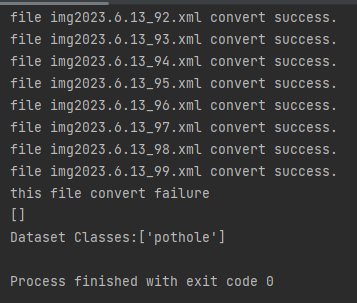
这里的pothole即为标签类别。
7.划分训练集、验证集、测试集
在文件夹路径YOLO v8\ultralytics-main\ultralytics\yolo\v8\detect下,新建datasets文件夹
将第6章处理后得到的VOCdevkit文件夹复制粘贴到datasets文件夹中,并删掉其中的Annotations文件夹
在datasets文件夹中新建split_data.py文件
在split_data.py文件中放入以下代码并运行,这个文件是划分训练、验证、测试集。其中支持修改val_size验证集比例和test_size测试集比例,可以在代码中找到val_size和test_size进行修改。
import os, shutil
from sklearn.model_selection import train_test_split
val_size = 0.05
test_size = 0.1
postfix = 'jpg'
imgpath = 'VOCdevkit/JPEGImages'
txtpath = 'VOCdevkit/txt'
os.makedirs('images/train', exist_ok=True)
os.makedirs('images/val', exist_ok=True)
os.makedirs('images/test', exist_ok=True)
os.makedirs('labels/train', exist_ok=True)
os.makedirs('labels/val', exist_ok=True)
os.makedirs('labels/test', exist_ok=True)
listdir = [i for i in os.listdir(txtpath) if 'txt' in i]
train, test = train_test_split(listdir, test_size=test_size, shuffle=True, random_state=0)
train, val = train_test_split(train, test_size=val_size, shuffle=True, random_state=0)
print(f'train set size:{len(train)} val set size:{len(val)} test set size:{len(test)}')
for i in train:
shutil.copy('{}/{}.{}'.format(imgpath, i[:-4], postfix), 'images/train/{}.{}'.format(i[:-4], postfix))
shutil.copy('{}/{}'.format(txtpath, i), 'labels/train/{}'.format(i))
for i in val:
shutil.copy('{}/{}.{}'.format(imgpath, i[:-4], postfix), 'images/val/{}.{}'.format(i[:-4], postfix))
shutil.copy('{}/{}'.format(txtpath, i), 'labels/val/{}'.format(i))
for i in test:
shutil.copy('{}/{}.{}'.format(imgpath, i[:-4], postfix), 'images/test/{}.{}'.format(i[:-4], postfix))
shutil.copy('{}/{}'.format(txtpath, i), 'labels/test/{}'.format(i))
运行以上代码后将会在datasets文件夹中生成images和labels文件夹,其中分别存有训练集、验证集和测试集的图片及标签文件。
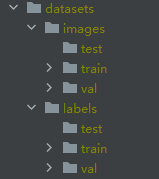
8.训练自己的模型
(1)在YOLO v8\ultralytics-main\ultralytics\yolo\v8\detect\文件夹下.yaml文件,命名为data
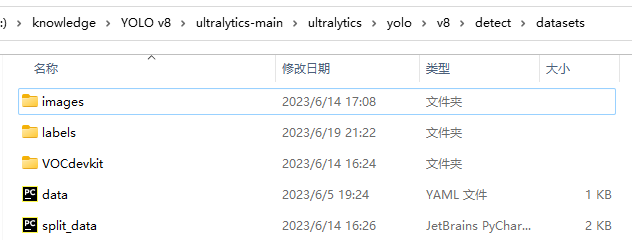
在data.yaml文件中放入以下代码:
# dataset path
train: E:\knowledge\YOLO v8\ultralytics-main\ultralytics\yolo\v8\detect\datasets\images\train
val: E:\knowledge\YOLO v8\ultralytics-main\ultralytics\yolo\v8\detect\datasets\images\val
test: E:\knowledge\YOLO v8\ultralytics-main\ultralytics\yolo\v8\detect\datasets\images\test
# number of classes
nc: 1
# class names
names: ['pothole']
(2)找到YOLO v8\ultralytics-main\ultralytics/yolo/configs文件路径下的default.yaml文件
task设置为detect;
mode设置为train;
model后设置为预训练模型的文件路径;
data后设置为(1)中所述的data.yaml文件的绝对路径;
epoch设置为自己所需的训练轮数;
batch根据自己电脑配置进行设置
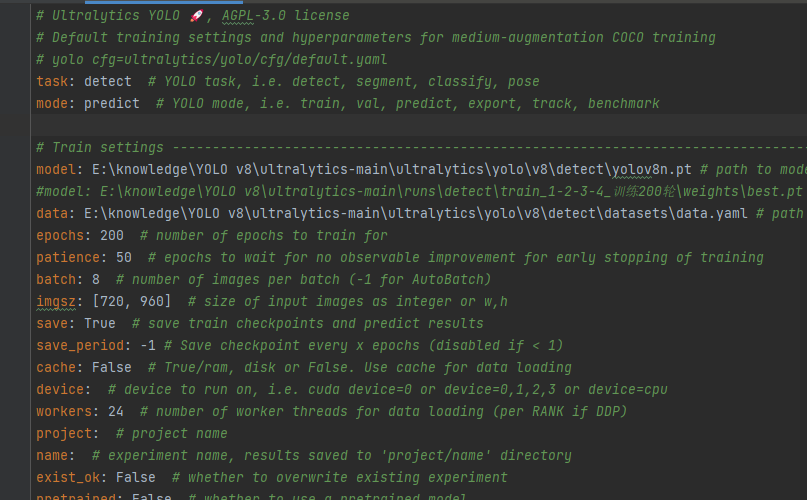
(3)开始训练
在终端中输入以下命令回车,即可开始训练
yolo cfg=ultralytics/yolo/cfg/default.yaml